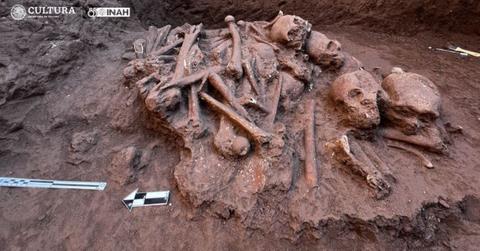Grave Discovery: Ritualistically Arranged Human Bones Discovered During Mexican Sewer System Excavation

The burial site discovered in Mexico, which dates back 1,500 years, archaeologists say.
Archaeologists in Mexico have unearthed a burial site dating back 1,500 years, revealing a fascinating glimpse into ancient rituals and practices.
The discovery occurred during the construction of a sewer system at Pozo de Ibarra in Nayarit, a state in western Mexico, as reported by the National Institute of Anthropology and History (INAH).
The burial site contained a variety of human remains, meticulously arranged in what appears to be a ritualistic manner. Among the findings was a complete skeleton alongside bones from other individuals.
Notably, certain bones were deliberately stacked and organized into different groupings. Claudia Servín Rosas, a field archaeologist leading the excavation, highlighted the presence of seven intact skulls, as well as the separation of long bones like femurs and tibias.
Analysis of the remains revealed intriguing details about the deceased. All the skulls belonged to males of varying ages, some displaying signs of cranial modification, a common practice in Mesoamerican cultures.
The simultaneous interment of the bones and the nature of the funerary rituals bore resemblance to customs observed during the Amapa era, spanning from A.D. 500 to 850.
Never miss a story — sign up for the Front Page Detectives newsletter. Be on the scene the moment news breaks.
The discovery was further corroborated by the presence of ceramic vessels and figurines at the site, which aligned with artifacts from the same historical period.
Servín Rosas speculated that the burial might have been part of familial funerary rites associated with the establishment of new settlements. However, such practices seem unique to this discovery, lacking evidence of similar occurrences in the region.
Efforts are underway to preserve the remains in collaboration with local authorities, ensuring their availability for future study.
Become a Front Page Detective
Sign up to receive breaking
Front Page Detectives
news and exclusive investigations.
